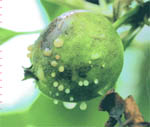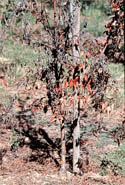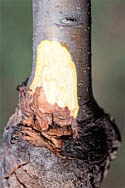Reports on Plant Diseases |
| RPD No. 801 -
Fire Blight |
September
1999 |
[ Symptoms
] [ Disease Cycle ] [ Control
] [ Resistance Tables ]
|
Fire blight, caused by the bacterium Erwinia amylovora, is a common
and very serious bacterial disease. The disease is also referred to as
blossom blight, spur blight, fruit blight, twig blight, or rootstock blight
– depending on the plant part that is attacked. Erwinia amylovora
infects approximately 75 different species of plants, all in the family
Rosaceae. The hosts for this bacterium include apple, blackberry, cotoneaster,
crabapple, firethorn (Pyracantha), hawthorn, Japanese or flowering
quince, mountain-ash, pear, quince, raspberry, serviceberry, and spiraea.
The cultivated apple, pear, and quince are the most seriously affected
species, but many ornamentals serve as overwintering hosts for the bacterium
and are important sources of new infections each year.
|
Click
on image for larger version

Figure 1. Infected
blossoms wilt, turn light
to dark brown on apple,
black on pear. |
|
Click on images for
larger versions

Figure 2. Rough
corky
tissue forms at margin
of canker

Figure 3. Apple
shoots
affected by fire blight.
Note
"shepherd's crooks" at the
tips. (Photo courtesy of
A.L. Jones, Michigan
State University.)

Figure 4. Droplets
of
bacterial ooze on immature
apple. (Photo courtesy of
A.L. Jones, Michigan
State University.)
|
Losses from fire blight in apples and pears include: (1) death or severe
damage to trees in the nursery; (2) death of young trees in the orchard;
(3) delay of bearing in young trees due to frequent blighting of shoots
and limbs; (4) loss of limbs or entire trees in older plantings as the
result of girdling by fire blight cankers; and (5) partial loss of the
crop by the blighting of the blossoms and young fruits.
The seriousness of fire blight is demonstrated by its effect on the commercial
pear industry. At one time, the pear was a popular and widely grown fruit
in the Midwest, comparable in importance to the apple. Fire blight has
eliminated the possibility of commercial pear production in most areas
of the Midwest.
Symptoms
The fire blight bacterium can infect any portion of a susceptible plant.
The common types of infection are blossom blight, shoot blight, and branch
and trunk canker. Blossom blight is most common on pear, apple, hawthorn,
mountain-ash, and Pyracantha. Infected blossoms become water-soaked
and darker green as bacteria invade new tissues. Within 4 or 5 days fruiting
spurs may begin to collapse, turning dark brown to black (spur blight)
(Figure 1).
The leaves wilt, die, and turn dark brown to black, usually remaining
attached to the tree throughout the summer. As the bacteria move through
the pedicel, the tissue becomes water-soaked and dark green. Infected
tissues may exude either small droplets of a milky-white ooze or fine,
hairlike strands containing millions of fire blight bacteria that can
initiate new infections. The ooze, which later turns an amber color, contains
countless bacteria that also are capable of causing new infections.
Shoot blight is recognized by the rapid dieback of shoots. Infections
begin in the shoot tips and move rapidly down from one to twelve inches
a day. Newly infected tissue becomes water-soaked and dark green or reddish
brown in color. As in spur blight, infected leaves die and turn either
dark brown (apple, crabapple) or black (pear) and remain attached throughout
the growing season. Frequently, the tip of the blighted shoot bends over
and resembles a shepherd's crook (Figure 3). Hawthorn leaves turn yellow,
then brown, shrivel, and fall prematurely.
The terminal shoots of Jonathan apple trees are often blighted back 12
to 36 inches (30 to 90 centimeters). The infection may continue down a
shoot or flower spur into a larger branch or trunk, forming a canker.
These cankers continue to enlarge during the growing season and may girdle
the affected part, resulting in the death of the entire branch or tree.
The surface of a canker is somewhat sunken, relative to the surrounding
healthy tissue, and the bark is usually darker in color. A distinct zone
of rough, corky tissue may form at the margin of the canker (Figure 2
and 6). In some cultivars, it is difficult to determine the margin of
the canker without cutting into the wood to expose the discolored and
infected tissue. The diseased inner bark of older branches becomes reddish
brown and marbled, in contrast with the whitish color of normal wood.
The surface of smooth-barked branches darkens; also, cracks usually develop
at the margins of the diseased area.
|
|
Fruits are susceptible to infection until just before maturity. The
incidence of fruit infection is usually low; however, infections can follow
mechanical injury such as hail or insect feeding. Diseased fruit is first
water-soaked, turns brown, shrivels, and turns black. Droplets of milky
and sticky bacterial ooze are commonly observed on the fruit surface during
wet, humid weather (Figure 4).
A phenomena called "rootstock blight" usually occurs in high
density orchards planted with susceptible rootstock such as M.9 and M.26.
Rootstock blight is caused by formation of cankers on susceptible rootstocks
which can completely girdle and kill the tree in one to a few months (Figures
5 and 6). The bacteria in the infected blossoms or shoots pass through
healthy limbs and trunks and reach the rootstock and produce the cankers.
Root suckers and sprouts from susceptible rootstocks also may become infected,
much as do the shoots. These infections can also lead to the invasion
of the entire root system and the rapid death of the tree. Fire blight
is often followed by Black Rot and Wood Rot.
|
Click on image for larger version

Figure 5. A
three-year old
Fugi apple tree killed from
infection of M.9 root
stock by fire blight.
|
|
Back to Top
Disease Cycle
The fire blight bacteria overwinter in living tissue at the margins of
trunk and branch cankers that were formed by infections initiated in previous
years, and possibly in buds. The bacteria resume growth in the spring
when temperatures are above 65° F (18° C) with survival favored
by rain, heavy dews, and high humidity. By the time trees are blossoming,
ooze containing bacteria are present on the surface of cankers. Relatively
few cankers survive winter, become active, and produce bacteria in the
spring. However, a single active canker will produce millions of bacteria,
enough to infect an entire orchard. The cankers most likely to produce
bacteria in the spring are those with smooth margins between healthy and
infected tissue, and those formed in older wood. Cankers produce bacteria
in droplets of ooze that are spread by splashing rain or insects (mostly
bees, flies, and ants) to open blossoms. The bacteria multiply rapidly
on the blossom and invade the tissue through the nectaries (non-cutinized
or flower parts). The bacteria then spread from blossom to blossom by
rain or pollinating insects. The optimum temperature range for blossom
blight infection is 65° to 86° F (18° to 30° C).
|
Click
on image for larger version

Figure 6. Fire
blight on
the M.9 root stock of
an apple tree. |
Succulent shoot tips are frequently infected by bacteria that have been spread
from cankers and infected blossoms. The invasion of shoot tips can occur through
natural openings, such as lenticels and stomata, but more commonly through wounds
created by sucking insects such as aphids, leafhoppers, and tarnished plant
bugs, by wind whipping, or by hail. The fire blight bacteria reproduce rapidly
within an infected shoot. Droplets of ooze form on the shoots within three days.
This ooze serves as a source of inoculum for the further spread of the disease.
Shoots remain highly susceptible to infection until vegetative growth ceases
and the terminal bud forms.
Warm (optimum temperature 76° F or 24° C) and moist weather is favorable
for infection, and rapid growth encourages disease development. Nitrogen fertilization,
late fertilizer application, poor soil drainage, and other factors that promote
succulent growth or delay the hardening of the tissues from midsummer into autumn
tend to increase the severity of this disease.
Dried bacterial ooze remains infectious for more than a year if it is not subjected
to alternate wetting and drying. Contaminated boxes or other containers that
are taken into orchards for fruit picking may serve as a potential source of
infection.
Back to Top
Control
No single method is adequate to effectively control fire blight. A combination
of practices is needed to reduce the severity of the disease.
-
Choose the proper cultivars. Apple cultivars differ widely in their
susceptibility to fire blight (Table 1 and Table
2). During warm and rainy weather, cultivars rated moderately susceptible
or moderately resistant will develop shoot infections; however, the extent
to which shoot infections progress will be less in resistant cultivars than
in susceptible cultivars. Commercial growers should select rootstocks
that are less susceptible to fire blight. Bartlett pears are extremely susceptible
to fire blight and are not recommended for planting in Illinois.
-
Select planting sites with good soil drainage. Trees are more susceptible
to fire blight in poorly drained sites than in well-drained ones. Tree productivity
will also be lower on such sites. Drainage can often be improved by tiling.
-
Follow proper pruning and fertilization practices. Using nitrogen
containing fertilizer and/or doing heavy pruning promotes vigorous growth
and increases susceptibility. Fertilization and pruning practices on susceptible
cultivars should be adjusted to limit excessive growth. For bearing
trees, moderate shoot growth is 6 to 12 inches (15 to 30 centimeters) per
year. If the growth is more than 12 inches, do not apply fertilizer until
shoot growth is reduced to less than 6 inches.
Apply fertilizer in the early spring (6 weeks before bloom) or apply in
late fall after growth has ceased. Applications in midseason prolong the
time during which shoots are susceptible to infection and increase the likelihood
of winter injury to tender wood.
-
Prune out fire blight cankers during the dormant season. Delay
the removal of infected shoots until the dormant season in order to avoid
spreading infection to healthy shoots. Make pruning cuts at least 6 inches
(15 centimeters) below the last point of visible infection. After each pruning
cut, sterilize the pruning shears by dipping them in a freshly made solution
of 1 part liquid bleach (Clorox, Purex, Saniclor, Sunny Sol) added to 4
parts of water. Examine the larger branches and trunks carefully for cankers,
since these are likely to overwinter and produce new infections in the spring.
Root suckers and watersprouts should also be removed because infection of
these parts can lead to infection and death of entire trees. Certain dwarfing
rootstocks used for apples are prone to suckering. Commercial growers should
select rootstocks that are resistant to fire blight or that show little
tendency to produce root suckers.
Examine wild, neglected, ornamental hosts of the fire blight bacterium growing
in the vicinity of home or commercial orchards for cankers. In addition
to seedling apples, crabapples, pears, and quince, check hawthorns (Crataegus
spp), firethorns (Pyracantha spp), cotoneasters, mountain-ashes (Sorbus
spp), and spiraea. Remove the cankers when found or destroy the entire plant
where feasible.
-
Follow a bactericide spray program. Like most bacterial diseases
of plants, fire blight is very difficult to control; however, it can be
reduced by spraying. Commercial orchardists should follow the spray schedule
outlined in the annual Midwest Tree Fruit Pest Management Handbook. The
antibiotic streptomycin is the most effective material for controlling fire
blight; timely sprays will reduce the incidence of fire blight but must
be applied before the appearance of symptoms.
Temperatures at the prebloom and bloom stages are important in determining
whether fire blight will occur in any given year. The bacteria reproduce
only when the temperature is warmer than 65° F (18° C).
The following concept was developed for predicting outbreaks of blossom
blight in Illinois. The first idea to understand is that of a "heating
degree-day." A "degree-day" occurs when the maximum daily
temperature reaches 66° F (19° C). Start counting degree days after
each spring frost. A freeze greatly reduces the number of fire blight bacteria
in holdover cankers and on tree surfaces. Bacteria reach dangerous population
levels ONLY after 30 degree-days have elapsed since the last frost. Degree-days
may be accumulated in a variety of ways; for example, 2 days with a maximum
daily temperature of 80° F (27° C), 3 days of 75° F (24°
C), or 6 days of 70° F (21° C) following a freeze will provide enough
accumulated warmth to allow bacterial populations to increase greatly in
number and present a serious fire blight threat to blossoms. When 30 degree-days
have occurred and when blossoms are still present (including secondary bloom),
apply the first streptomycin spray. Repeat the spray at 4-day intervals
through the bloom period. At temperatures above 86° F (30° C), bacteria
will not multiply. Therefore, it is not necessary to apply streptomycin
when the temperatures average below 65° F or above 86° F.
Dr. Paul Steiner at the University of Maryland has developed a computer
software package which very accurately predicts the potential for fire blight
occurrence. The prediction is based upon temperature and moisture during
bloom. This computer software is called MARYBLYT and is available from the
University of Maryland, Department of Botany, College Park, MD 20742.
Streptomycin can effectively protect the susceptible apple and pear flowers,
but for maximum effect it must be applied the day of, or the day before
infection event occurs. Missing the critical window of effectiveness by
even 24 hours can result in plant infection and buildup of a significant
amount of bacteria for later infections. If the blossom blight is well controlled,
the subsequent increase of fire blight in summer is often prevented. To
prevent development of streptomycin-resistant strains of the pathogen, no
more than 4 applications of streptomycin per season is recommended. Streptomycin
is more effective in preventing blossom infection and the management of
the shoot blight phase of fire blight should not be attempted with streptomycin.
However, application of streptomycin immediately following hail storms is
highly recommended. Streptomycin is most effective when applied alone, as
a dilute spray, under slow drying conditions (generally between 10 p.m.
and 3 a.m.), and when daytime temperatures reach 65° F or above. Apply
100 parts per million (ppm) of streptomycin if the temperature is below
65° F, and 50 ppm if the temperature is above 65° F.
Bordeaux mixture (6-6-100), made by mixing 6 pounds of crystalline copper
sulfate (bluestone or blue vitriol) and 6 pounds of fresh hydrated spray
lime in 100 gallons of water, will help control fire blight but may cause
russeting of the fruit. Bordeaux mixture is recommended for use by growers
who had a severe epidemic the previous year. Bordeaux mixture should be
applied at the green tip to quarter inch green stage of flower bud growth.
Do not mix bordeaux with other chemicals, and use it as soon as it is prepared.
Do not follow bordeaux mixture with streptomycin, and do not concentrate
bordeaux mixture greater than 2 times. Bordeaux is not as effective as streptomycin
in controlling fire blight.
Copper sulfate (4 lb/100 gal or 2kg/400 liters), applied when trees are
dormant in early spring also helps reduce the number of bacteria present
in ooze on cankers and thus slows the buildup of bacteria in the orchard
prior to bloom.
- Control sucking insects. Good control of aphids, leafhoppers, plant
bugs, and psylla on pears helps prevent shoot infection. Commercial orchardists
should follow a spray program outlined in Midwest Tree Fruit Pest Management
Handbook. [Copies of the circular mentioned are available at your nearest
Extension Office or from Information Technology and Communication Services
(ITCS), 1401 S. Maryland Dr., Urbana, IL 61801 (217/333-2007).]
Back to Top
Table 1. Relative Susceptibility of
Common Apple Cultivars and Rootstocks to Fire Blight.
| Highly susceptible |
Moderately susceptible |
Moderately resistant |
Resistant |
|
APPLE
Beacon
Braeburn
Burgundy
Cortland
Fuji
Gala
Idared
Jonathan
Lodi
Molly's Delicious
Niagara
Nittany
Paulared
R.I. Greening
Rome Beauty
Twenty Ounce
Tydeman Early
Wayne
Wealthy
Winter Banana
Yellow Newton
Yellow Transparent
York Imperial
|
Baldwin
Ben Davis
Empire
Golden Delicious
Granny Smith
Gravenstein
Grimes Golden
Jerseymac
Jonafree
Jonagold
Jonamac
Macoun
McIntosh
Monroe
Mutsu
Northern Spy
Spartan
Stayman
Summer Rambo
|
Arkansas Black
Delicious
Liberty
Northwestern
Greening
Priam
Prima
Priscilla
Quinte
Redfree
Sir prize
Winesap
|
|
|
PEAR
Anjou
Aurora
Bartlett
Bosc
Clapp's Favorite
Red Bartlett
Reimer Red
Starkrimson
|
Asian Pearsa
Hosui
Shinseiki
Harrow Delight
Maxine
Seckel
|
Kieffer
Magnessb
Moonglow
Old Home
Starking Delicious
|
Bradfordc
|
a Reactions of these pear-apples are relatively
unknown
b Susceptible to trunk infections
c Ornamental tree - no edible fruit |
|
ROOTSTOCKS
Alnarp 2
C.6 (interstem)
M.9
M.9 (interstem)
M.26
M.27
Mark
|
Bemali
MM.106
MM.111
Ottawa 3
|
M.7
Novole
Robusta 5
|
|
Table 2. Modern Crabapples not suggested
for Illinois but highly resistant or immune to Rusts,
Scab, Fire Blight, Powdery Mildew and Frogeye Leaf Spot
cv Ames White
cv. Baskatong
cv. Burton
cv. Case Seedling
cv. Golden Gem
cv. Golden Gem
(BD 115-58) |
cv. Golden Gem (PLT 788-58)
cv. Henningi
cv. Henry Kohankie
cv. Honeywood #14 hybrid
(scab immune clone GR 700-58)
cv. Minn. 1492
cv. Morden 19-27 |
c. Mount Arbor Special
c. Professor Sprenger
c. R.M.F. 102
cv. Robinson
cv. Simpsin 4-28
cv. Simpson 11-57
cv. Simpson 11-58 |
For further information concerning diseases of crucifers
and other vegetables, contact Mohammad Babadoost, Extension Specialist in Fruit
and Vegetable Pathology, Department of Crop Sciences, University of Illinois
at Urbana-Champaign.
University of Illinois Extension provides equal
opportunities in programs and employment.
|



